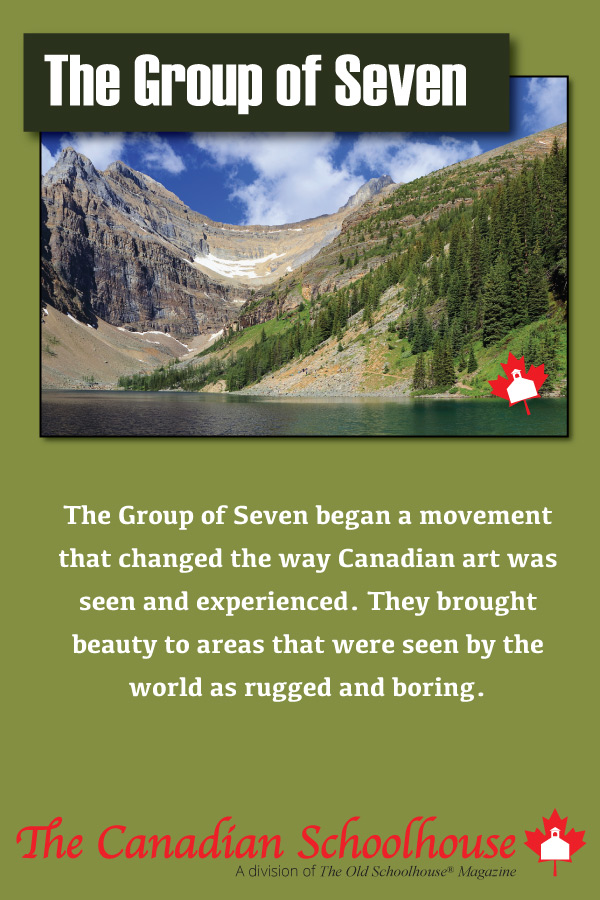

Artists have been able to take in a natural sight and put what they see on canvas for us to enjoy as well.
For many years, Europe was thought to be the most beautiful place for landscape artists to work, while Canada was seen as unworthy of an artist’s time.
This all changed in 1910. Seven artists created a group to showcase the beauty in the Canadian landscapes. They later gave themselves the name, The Group of Seven, and began exhibiting their work in 1920.
The Group of Seven began a movement that changed the way Canadian art was seen and experienced. They brought beauty to areas that were seen by the world as harsh and boring. As a group, they made it a point to showcase the rugged natural world of Canada in a beautiful way.
The seven initial members of The Group of Seven were Franklin Carmichael, Lawren Harris, A.Y. Jackson, Frank Johnston, Arthur Lismer, J.E.H. MacDonald, and Frederick Varley.
Each of the seven artists made their mark in art history as a member in The Group of Seven.
Franklin Carmichael
Carmichael became a part of The Group of Seven because his initial plans to study painting in Belgium were interrupted due to the war. Carmichael focused his paintings in Ontario and used watercolour and oil paints. He chose to paint northern Ontario landscapes and industrial buildings while bringing a spiritual view into his paintings. He eventually focused on watercolours only and later in his career began creating wood engravings and linocuts.
Lawren Harris
Harris is one of the best known from The Group of Seven. His paintings of Lake Superior, in particular the North Shore, are where he found his passion. He began to interlace spiritual and material items within his work and his deep colours, and thick impasto painting techniques made his work recognizable. As his work progressed, he began a more abstract and simple approach to his paintings.
A.Y. Jackson
Jackson’s time in the Canadian army made an impact on his edgy painting style. His discouragement of art in Canada led him to a decision to move to the United States. But after receiving a letter from the members of The Group of Seven, he decided to stay in Canada instead of moving and became one of the founding members of the group. He spent a lot of his time painting the St. Lawrence River, the Arctic, and British Columbia. His bold style brought a new perspective to the Canadian landscapes.

Frank Johnston
Johnston was the only painter in The Group of Seven to use Tempera paint. Johnston’s paintings exhibited texture and pattern, and as his career progressed, became more realistic. His choice places to paint were Algonquin Park and Lake Superior.
Arthur Lismer
Lismer was inspired by Belgium Post Impressionism and the Barbizon techniques. He was skilled with both pencil and paper as well as painting. His paintings were organic and spiritual, and later his emphasis on geometric forms and use of brush strokes gave an emotional effect to his work.
J.E.H. MacDonald
MacDonald is considered the founding father of The Group of Seven, and after his death, the group quickly broke apart. His paintings are admired for their beautiful brushwork, colour, and intensity. His place of choice to paint was the Canadian Rockies.
Frederick Varley
Varley began painting landscapes of Northern Ontario. His experience during the war as an “overseas artist” greatly influenced his art. His paintings of fire on the wilderness and harsh weather show the effect of the war on his mind. His work with The Group of Seven is focused on his landscape paintings, but his passion was actually portrait painting.
Each artist in The Group of Seven, brought their own experiences, education, and personality to their work. They exhibited until 1931 as The Group of Seven. Soon, as their art was more accepted, they became part of The Canadian Group of Painters.
Many other artists were discovered and encouraged by The Group of Seven artists, like Emily Carr who was noticed by Lawren Harris and welcomed by all members of The Group of Seven. Her artwork became well known, and some pieces sold for millions. She painted landscapes as well as villages and First Nations artifacts.
This article has been written by homeschooling staff writers of The Canadian Schoolhouse (TCS). Enjoy more of our content from TCS contributors and staff writers by visiting our themes page that has a new theme topic added every month!














